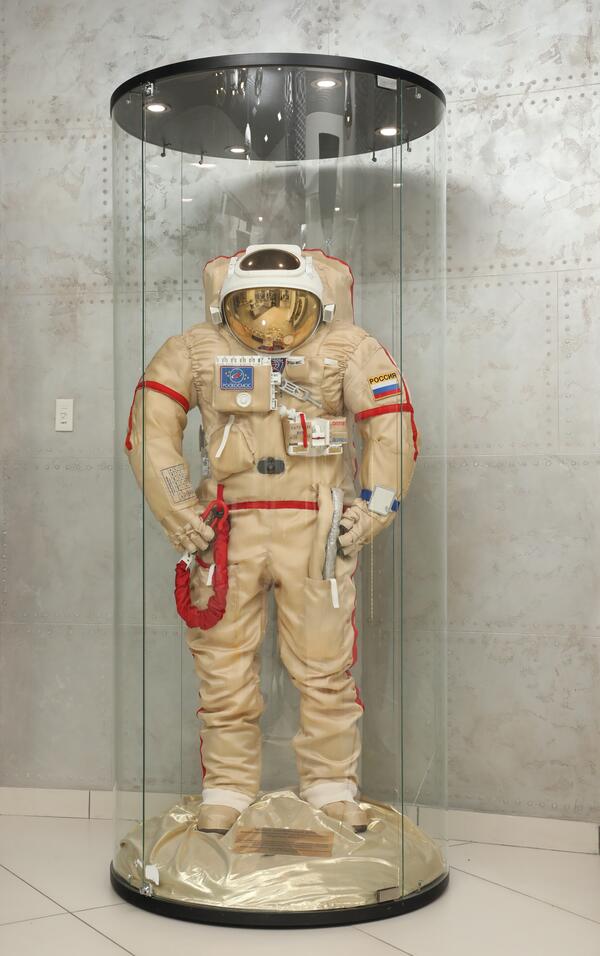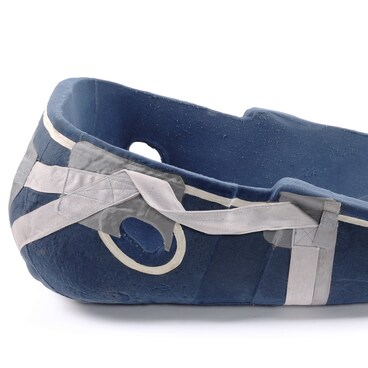The space suit was invented to protect humans in space. There are three types of space suit, with different purposes: emergency and rescue suits, space suits for use on spacewalks, and suits for use on the surface of other planets.
The human organism is not able to survive in space without a special protective system. At an altitude of just 5 kilometers above the Earth’s surface a person may start to experience the harmful effects of oxygen deprivation, and above 9 km it is impossible to breathe — the concentration of oxygen in the atmosphere is too low. Another factor that can result in death is low air pressure — the nitrogen in our bodies turns into gas, preventing our blood from circulating properly and causing severe pain — this is known as decompression sickness. It should also be noted that at low air pressures water boils at less than 100°C. At a height of 19km (the Armstrong line) the water in our bodies would boil at the temperature of approximately 37°, that is, at our normal body temperature. Without the protective layer formed by our atmosphere, humans are particularly vulnerable to cosmic radiation and temperature fluctuations — the surfaces of objects orbiting the Earth can heat up to 150°C when exposed to direct sunlight, and drop to –150°C in the shade.
The first person to go on a spacewalk (i.e. to venture into open space) was the Soviet cosmonaut Alexei Leonov, on March 18, 1965, wearing a Berkut space suit. In 1977 Yuriy Romanenko and Georgiy Grechko were the first to test the Orlan-D new generation space suit. This was a semi-rigid suit, consisting of a rigid frame (a Hard Upper Torso) made of an aluminum alloy, and soft flexible encasements for the arms and legs. Embedded into the hard frame was a convex porthole, which provided a wide angle of view and was fitted with a retractable filter with a gold anti-glare coating, which protected the eyes from direct solar radiation. The back of the spacesuit, which looks like a backpack, houses the life support system, which maintains the necessary air pressure, air composition, temperature and humidity, and which removes any human waste.
The Orlan-MKS is the latest version of this range of Russian space suits. It was first used by the cosmonaut Yuriy Yurchikhin during his spacewalk from the International Space Station on August 17, 2017. The letters MKS in the suit’s name stand for ‘modernized, computerized and synthetic’. It is different from earlier versions in that it has an automatic thermal regulation system, and the rubber encasements have been replaced with polyurethane ones, making the space suit more comfortable to wear and increasing its service life. It is lighter than its predecessor, weighing 114 kg.
Before being ‘packed’ into this space suit, the cosmonaut puts on special underwear and a thermal suit which incorporates pipes through which water flows for cooling purposes. But putting on the Orlan-M suit itself does not take long — the back opens like a fridge door, and the wearer just walks in.
The human organism is not able to survive in space without a special protective system. At an altitude of just 5 kilometers above the Earth’s surface a person may start to experience the harmful effects of oxygen deprivation, and above 9 km it is impossible to breathe — the concentration of oxygen in the atmosphere is too low. Another factor that can result in death is low air pressure — the nitrogen in our bodies turns into gas, preventing our blood from circulating properly and causing severe pain — this is known as decompression sickness. It should also be noted that at low air pressures water boils at less than 100°C. At a height of 19km (the Armstrong line) the water in our bodies would boil at the temperature of approximately 37°, that is, at our normal body temperature. Without the protective layer formed by our atmosphere, humans are particularly vulnerable to cosmic radiation and temperature fluctuations — the surfaces of objects orbiting the Earth can heat up to 150°C when exposed to direct sunlight, and drop to –150°C in the shade.
The first person to go on a spacewalk (i.e. to venture into open space) was the Soviet cosmonaut Alexei Leonov, on March 18, 1965, wearing a Berkut space suit. In 1977 Yuriy Romanenko and Georgiy Grechko were the first to test the Orlan-D new generation space suit. This was a semi-rigid suit, consisting of a rigid frame (a Hard Upper Torso) made of an aluminum alloy, and soft flexible encasements for the arms and legs. Embedded into the hard frame was a convex porthole, which provided a wide angle of view and was fitted with a retractable filter with a gold anti-glare coating, which protected the eyes from direct solar radiation. The back of the spacesuit, which looks like a backpack, houses the life support system, which maintains the necessary air pressure, air composition, temperature and humidity, and which removes any human waste.
The Orlan-MKS is the latest version of this range of Russian space suits. It was first used by the cosmonaut Yuriy Yurchikhin during his spacewalk from the International Space Station on August 17, 2017. The letters MKS in the suit’s name stand for ‘modernized, computerized and synthetic’. It is different from earlier versions in that it has an automatic thermal regulation system, and the rubber encasements have been replaced with polyurethane ones, making the space suit more comfortable to wear and increasing its service life. It is lighter than its predecessor, weighing 114 kg.
Before being ‘packed’ into this space suit, the cosmonaut puts on special underwear and a thermal suit which incorporates pipes through which water flows for cooling purposes. But putting on the Orlan-M suit itself does not take long — the back opens like a fridge door, and the wearer just walks in.



